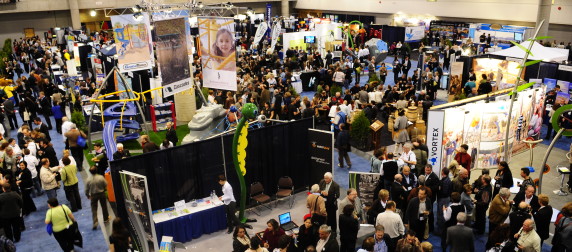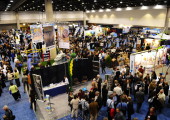In many business verticals, Spring/Summer is trade show season. If your marketing plan includes trade shows for your vertical or peripheral industries, and your booth selections and floor plans are set, now you’re facing the task of pulling together a strategy, designing and fabricating a display of some sort, creating collateral and sales support materials, and training staff to get the biggest bang for your trade show buck.
That last piece of the puzzle, staff training, may be the most overlooked and the most mission critical to achieving your goals for each show.
Firms we’ve worked with treated staff training for trade shows as an after-thought, making seemingly random staff selections, and handing them a brochure and saying “learn this” – not a good idea. Some firms who hire spokesmodels do this, but their goal is different and the model’s role is different than a staff person.
If you’re going to spend many thousands of dollars leasing floor space, designing and fabricating a custom display, paying staff T&E to go to a show and work, feeding them, housing them, and paying expenses for them to entertain clients and potential clients, the people you send ought to at least be proficient enough to maximize the opportunity. Sending the mailroom manager, the receptionist, and two PR people because they are young, unattached, unconstrained and attractive will come back to haunt you when the results for the year’s sales come in. You’ll have a much harder time justifying your budget for trade shows if you don’t show good results. Sending the whole sales team may backfire as well, without at least a few technical people there to answer some of the tougher questions, and some senior management to run the show and meet with those key clients as a show of respect for their past and future business.
Proper selection of a good mix of professionals to man the booth is only part of the equation. Making sure they are all on the same page, with the same message and a similar approach, pushing the same products in the same way, speaking knowledgeably about your products or services, is critical to a good show result. They should all be taught how to use their booth time productively, to make the most of the opportunity, how to engage prospects, how to qualify them, how to screen them, how to steer them to the correct individual internally, how to appear and how to behave when they are “on stage” in the booth.
The other key element of trade show success is the follow-up. Studies by CEIR have shown that nearly 80% of all leads gathered at a trade show are NEVER followed-up. You paid for them, why not use them? When you calculate your cost of acquisition at that trade show for new customers, you’ll realize what a gold mine they can be, if you’ve done your homework and set up a system to make sure the leads generated get followed properly.
Some companies do this extremely well, and they usually let technology do the work for them. I know of several companies that go to shows with a complete set of pre-written e-mail follow-up letters, divided into different levels of interest, different product interests or whatever their scheme supports. As soon as a lead is logged, either from a business card or through the badge reader system, an e-mail is issued to follow up, send links to the company website, impart additional information, give out coupons, keys to prizes, whatever. Sales people have the opportunity to add personal notes to these, to add specific answers to technical questions. Sometimes these systems are extremely fast – I’ve received e-mails on my smart phone within minutes of leaving the booth!
Whatever system you employ, make sure the staff is trained to use it, and that they use it often. And remember, it’s not usually about quantity, it’s about quality. If there are lots of leads, but the resulting sales after diligent follow-up are low, maybe that’s not the best venue, and it should be reconsidered carefully for next year’s plan. On the other hand, if you only get five leads, but they all convert, your cost of acquisition will be very high!
Trade shows are a lot of work, use a lot of resources, and can be an extremely effective tool for generating new leads and new customers, for polishing your brand within the industry, for launching a new product, or for doing product research. But without a properly trained staff, good follow-up mechanisms, and a solid integration plan, all those dollars and hours are for naught. Good luck!
If you liked what you read here, and found it valuable and would like to read more, pick up a copy of “The Marketing Doctor’s Survival Notes”





